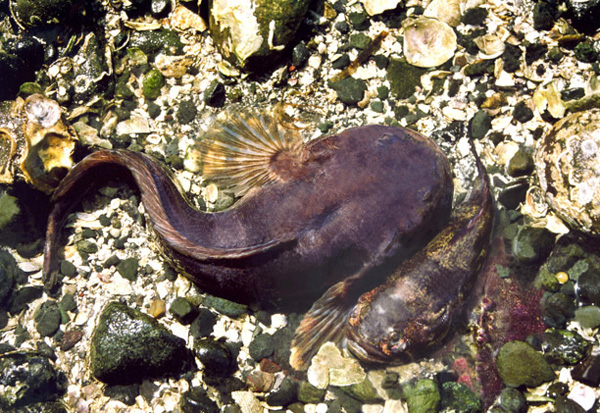What Does it Take to Hum an Hour-Long Mating Call? MBL Whitman Scientists Explain

By Stephanie M. McPherson
When Lawrence Rome comes back to the Marine Biological Laboratory’s Whitman Center summer after summer, he’s excited to see who he’ll find.
“Some of the scientists are there every summer, so you have good [ongoing] collaborations,” he says. “And other people come for one or two summers. So there’s this combination of a wash of new people every time the tide comes in, and a lot of long-term people.”
This has served him well over the years. Rome, a professor of biology at the University of Pennsylvania, first came to MBL to take the Experimental Invertebrate Zoology Course in 1976. He returned 10 years later as a Whitman Center scientist, and has spent every summer since in Woods Hole.
 To attract females (bottom), male Pacific midshipman fish (top) sound a continuous low hum for up to an hour. New findings shed light on how these creatures sustain 100 muscle contractions per second. Photo credit: Andrew Bass lab/Cornell University
To attract females (bottom), male Pacific midshipman fish (top) sound a continuous low hum for up to an hour. New findings shed light on how these creatures sustain 100 muscle contractions per second. Photo credit: Andrew Bass lab/Cornell UniversityRome studies muscles in fish. For the past few decades, he has focused on how a type of muscle known as “superfast muscle” helps some fish species produce their mating calls. One species, the toadfish, uses rapid pulses of this muscle to make half-second long calls every 10 seconds. Rome discovered the toadfish have an immense amount of a calcium binding protein (called Parvalbumin) that fills up during the call. The calcium then unloads and is pumped slowly during the long interval between calls to re-prime the system for the next call.
He wondered how this could be maintained in a related species called midshipman fish. Midshipman fish produce a hum for their mating call. But their call lasts a full hour (the longest call of any vertebrate). The superfast muscle pulses 360,000 times in that hour, or 100 times per second, leaving no downtime for the muscle to recharge. In a new paper with Whitman Scientist Frank E. Nelson, Rome and colleagues show that midshipman fish release far less calcium per pulse than their toadfish cousins, which permits the pumping of calcium to keep up in real-time to power the muscle through the hour-long hum.
When Rome started his investigations into midshipman fish, he welcomed the serendipity that naturally happens at a place like MBL.
“MBL convenes people, and some of that takes place on purpose, where you invite different people,” he says. “But in fact, a lot of the convening takes place randomly. People just show up in the summer and you talk to them and you find out a lot more information.”
Through casual conversation with new colleagues each summer, Rome was able to connect with experts on midshipman fish behavior from many different universities.
“I’m an expert on muscle, and less of an expert on behavior. And at least in my research, knowing how the muscle works while understanding the behavior is very important,” he says.
He has also discovered that Matthew Kittelberger, another MBL Whitman Scientist, kept midshipmen fish in MBL’s Marine Resources Center during several summers. This led to another collaboration between Rome, Kittelberger and Allen Mensinger, also a Whitman Scientist, to investigate why the swim bladder inflates to three times its usual size during these extreme mating calls.
“What has worked well for me [at MBL] is a less-structured version of science where you have lots of creative people show up. They work on their own stuff, but they’re also talking to other people,” says Rome. “It brings you a brand-new type of understanding.”
Citation:
Frank E. Nelson, Stephen Hollingworth, James O. Marx, Stephen M. Baylor, Lawrence C. Rome (2018) Small Ca2+ releases enable hour-long high-frequency contractions in midshipman swimbladder muscle. J. Gen. Phys. DOI: 10.1085/jgp.201711760